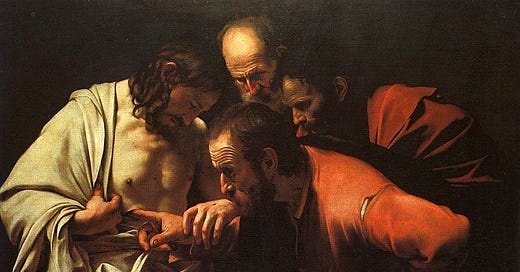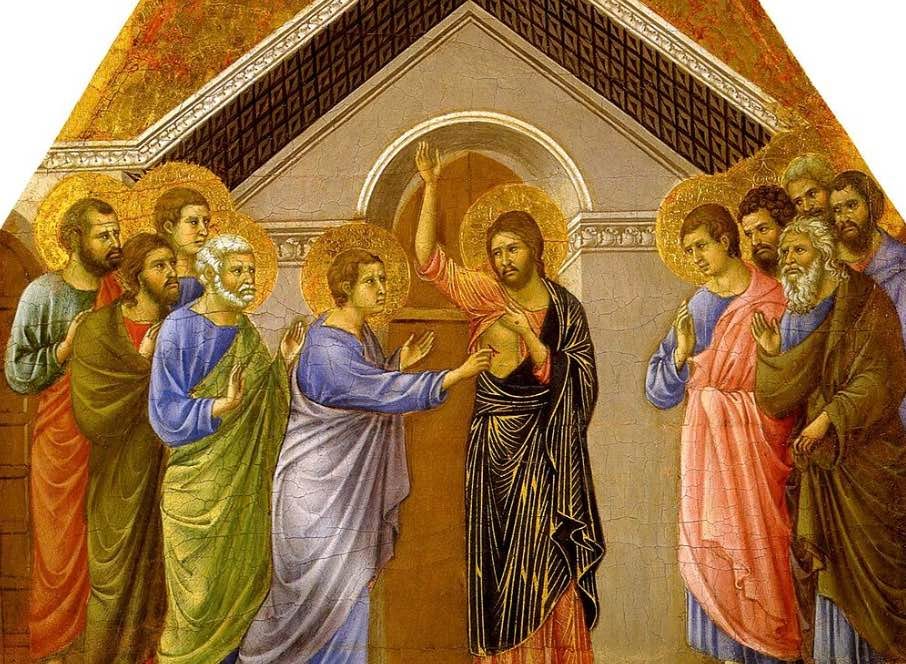Here we are a week after Easter Sunday morning, when Christians worldwide celebrated Jesus’s resurrection from the dead. Since last Sunday I’ve been preoccupied by one apostle—Thomas—and how the news about the resurrection hit him 2,000 years ago.
History remembers Thomas as “the Doubter,” which gives you the impression he had a habit of being skeptical. But we don’t know that. John is the only gospel writer to give us a glimpse into Thomas’s personality. He comes across as sometimes confused (““Lord, we don’t know where you are going, so how can we know the way?” [14:5]) but ultimately committed to following Jesus no matter what (“Let us also go, that we may die with him” [11:16]). Christian tradition suggests that Thomas was as good as his word on this point. He went to India as a missionary and died a martyr’s death there. But there’s this we can’t quite get around: when the other apostles tell Thomas they’ve seen Jesus—risen!—he replies, “Unless I see the nail marks in his hands and put my finger where the nails were, and put my hand into his side, I will not believe it (20:25).
And so it is that Thomas’s “doubting,” not his courage or martyrdom, sticks in our imaginations, inspiring famous paintings and countless sermons, I’m sure, about the importance of belief.
Maybe the reason I feel defensive about Thomas this Eastertide is because I know a lot of people right now whom many would call “doubters” but whose lives and motivations tell a more complicated story. They may be far and moving further from the Christian church, but many of them are not “doubters”—not in the way we often think. And neither was Thomas.
Let’s look at the evidence in the Bible.
The four gospel writers, like all eyewitnesses, describe the events a little differently. Taken together, they agree that:
Jesus appeared first to the women—Mary Magdalene and “the other Mary” and maybe others;
Then he appeared to the rest of the Eleven except for Thomas: two on the road to Emmaus first (Mark 16:12; Luke 24:13-35), and then the rest at a meal (Luke 24:36-49; John 20:19-23);
Finally he appeared to Thomas (John 20:24-29).
Read these other accounts of Jesus appearing to the women and the Eleven and two things become clear:
First, Thomas’s request to see and touch Jesus wasn’t remarkable. The women saw Jesus and touched him (i.e., John 20:17), and so did the Eleven (i.e., Luke 24:39). So Thomas didn’t demand anything the others hadn’t already received. I imagine the women and the Eleven told him, “Look, I know how this sounds. But we know it’s true, Thomas, because we saw him and even touched him.” Thomas didn’t ask for more evidence or new evidence. He only wanted the same confirmation everybody else already got: “Good for you, guys. But unless I see him and I touch him myself, I won’t believe it.” He’s the only one in the room who hasn’t seen or touched Jesus himself. And that’s all he wants in the world.
Second, Thomas’s doubt wasn’t remarkable. When the women told the Eleven they had seen Jesus, they didn’t believe them “because their words seemed to them like nonsense” (Luke 24:11). Mark says the Eleven doubted the women and the testimony of the two who met Jesus on the way to Emmaus (Mark 16:13).
In other words, Thomas is the last apostle to see Jesus alive after his crucifixion. He asks to see the same evidence everyone else has already seen. He expresses the same hesitation to believe that the Eleven expressed before him. And just like everyone else in the story, as soon as Thomas encounters the risen Jesus himself, he worships him without hesitation: “Thomas said to him, ‘My Lord and my God!’” (John 20:28).
And yet, and yet, we label him—not them!—the “doubter.” Why?
It’s probably because of what Jesus says to Thomas after all this happens. “Because you have seen me, you have believed; blessed are those who have not seen and yet have believed” (John 20:29). We might hear rebuke in Jesus’s words, as if Thomas is the exception to the rule. But here’s the thing—no one in the room believed without seeing. Not the women. Not the Eleven. All of them believed because they saw.
Jesus isn’t putting Thomas on blast here. He’s not contrasting him with the other apostles. In fact, Jesus rebukes the Eleven for their unbelief in the other accounts (Mark 16:14; Luke 24:38). So who are the ones who have not seen and yet have believed? John makes it plain in the following verses. He wrote his gospel, he tells us, “that you [the reader] may believe that Jesus is the Christ, the Son of God, and that by believing you may have life in his name” (John 20:31).
The ones who have not seen and yet have believed are the people reading John’s gospel, wherever they are in time and space. They are you and me. We believe because of the testimony of the women and the Eleven and the folks who wrote these stories down into the Gospels. Jesus’s comments encourage us to accept these people as faithful witnesses. We can believe without seeing because we can trust their testimony.
And this brings us back to the pastoral question at the top of this long reflection. There are lots of people in our churches today whom we might call “doubters.” They may say they are “deconstructing” their faith. They are a lot like Thomas in this regard: Thomas never doubted Jesus. As soon as he encountered Jesus himself, he worshipped without hesitation. Rather, Thomas doubted what the other apostles told him about Jesus. He didn’t doubt the Good News. He doubted the reliability of the witnesses who proclaimed that Good News.
Based on the conversations I’m having with people who are “doubting” or “deconstructing,” this is where many of them they are, too. They don’t doubt Jesus—they doubt what their home churches and the broader Christian community has to say about Jesus. They don’t doubt the Good News—they doubt the reliability of the witnesses who proclaim that Good News.
The reliability of the apostles’ witness was established by their very public relationship with Jesus in the gospels and their very public signs and wonders in the Book of Acts. People didn’t see Jesus when the apostles’ preached in Judea and Samaria and the ends of the earth. But they saw something. They saw courage and healings and baptisms in the Holy Spirit. These public displays affirmed their trustworthiness.
Today the public testimony of American Christianity is a mixed bag at best. People don’t see Jesus when we preach. But they see something. Some places they see courage and righteousness and reconciliation. Other places they see exploitation and abuse and greed and collusion with worldly powers. These very public displays undermine their trustworthiness.
And so many who “doubt” today don’t doubt Jesus. They view the institutions that claim to be his witnesses as salt that has lost its saltiness and needs to be tossed out (Matthew 5:13). They want a direct encounter with Jesus—like Thomas did—unmediated by witnesses of questionable credibility. Maybe they want to believe without seeing, but we have made it so very hard for them.
These “doubters” and “deconstructors” probably won’t be argued back into faith in the system. Instead, those of us in some form of spiritual leadership should examine ourselves and identify those things in our private lives and public witness that don’t look much like Jesus. If we want people to believe, we shouldn’t shame them for their unbelief. We should make every effort to become more trustworthy witnesses.





This is good Brandon, thanks for posting it again. I agree that Thomas is a helpful portrait for many Christians today. The context of Jesus’ appearance in John 20:19-29 is also notably different from the other gospels. John emphasizes the disciples fear of the oppressive religious leaders. Even after Jesus had appeared to them, they still locked the doors. And many scholars believe that 20:31 emphasizes the maintenance of belief, rather than beginning to believe (ie comforting and encouraging believers, vs the typically assumed evangelistic meaning). This fits the context of many today who are deconstructing because of spiritual abuse and high control religion that punishes those who challenge the status quo, even indirectly by asking their own questions. I wrote something along these lines earlier this year (but not specifically focused on deconstruction, that’s a helpful added layer). https://open.substack.com/pub/onceaweek/p/religious-trauma-and-the-new-temple?r=16589c&utm_medium=ios
Can you please do one of these on the disciples on the road in Luke 24 - and also do it before next Sunday? That'd be a big help, Brandon. Thanks! Chris